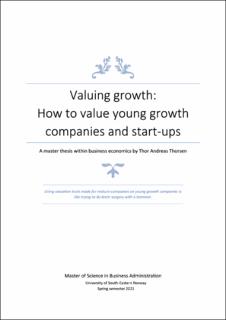| dc.description.abstract | This thesis focus on the valuation of young growth companies and start-ups. The research concerns the methods used, the drivers of value when applying those methods, and how to validate the drivers of value. Furthermore, the thesis provides a review of leading theory, recent research, and creative and non-traditional methods to value businesses in the earliest life stages.
The research has been conducted by interviewing Norwegian venture capitalists, a private full-time investor, and a private part-time investor. Those interviewed are all relevant due to their investments in applicable businesses. The interviews were carried out to gain clarity into the methods of practitioners to compare it with previous research and theory applicable for young growth businesses and start-ups.
The results are comparable to similar research where respondents describe a highly qualitative approach when assessing drivers of value. However, they diverge from leading theorists. This due to none of the respondents using the discounted cash flow method favored by leading theorists such as Damodaran and Koller. The analysis shows that venture capitalists often price start-ups with the five times the raise method and young growth businesses on price to sales.
However, the drivers of value applying these methods are where the real challenge lies. According to both the respondents and the comparable research highlighted in this thesis, human capital is the most important driver. In addition, other key drivers for estimating value are the size of the total addressable market, the product, and the business model.
To validate human capital the process gets abstract, approximate, and “fluffy”. However, it is based on the investors’ accumulated experience and training of continuously performing such assessments. Although, when the business matures into a young growth company the growth rates of sales and/or users serve as validation of the human capital and the business. | |
